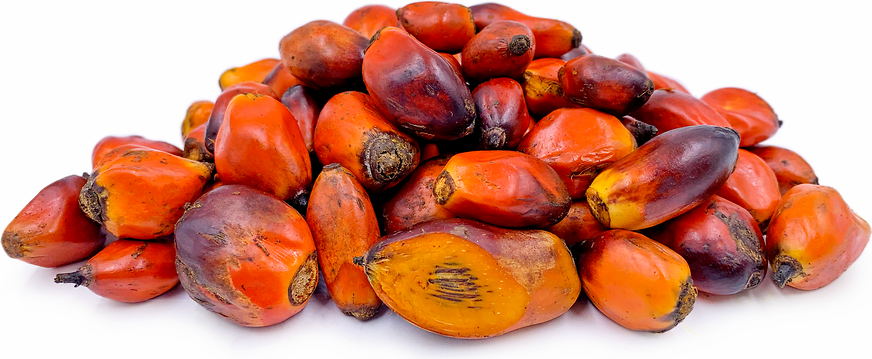


Red Palm Fruit
Estimated Inventory, lb : 0
Description/Taste
African Palm fruit, from the African oil palm (Elaeis guineensis) are small, ovoid-oblong fruits that grow in clusters of several hundred, close to the trunk on short heavy stalks. The fruits range in size from less than 1 inch to 2 inches and are black and red when ripe. The fruit is fibrous and oily and surrounds a white kernel, also rich in oils. Oil from the palm fruit is difficult to describe, but is smoky, distinct and strong in both flavor and aroma. According to one Portuguese explorer, “It smells of violets, tastes like olives and has a color that blends foods together like saffron, but even all this can’t sufficiently describe its special qualities.”
Seasons/Availability
Because the oil palm produces fruit continuously year round, with new bunches ripening each month, the fruit is always in season.
Current Facts
Elaeis guineensis is a tree in in the Arecacaea family along with coconut and date palms. The tree is a tall palm, reaching up to 20 meters, with a ringed trunk and a crown of 20-40 large leaves. Male and female flowers grow on the same tree in separate clusters. The fruit is borne in bunches, starting 3-4 years after germination and will ripen in 5-6 months after pollination. Each bunch contains hundreds of fruits which are similar in size to a small plum. Oil palm is the world’s number one fruit crop, produced in 42 countries worldwide on about 27 million acres. About 90% of palm oil produced finds its way into food products, the remaining 10% going to industrial uses, including soap, candles, lubricating greases and as an ingredient in pharmaceuticals.
Nutritional Value
Unrefined red palm oil is rich in antioxidants, vitamin E, vitamin A, vitamin K, carotenes, lycopene, tocotreinol, and tocopherols. It can be used in place of cod liver oil for correcting vitamin A deficiency. It is being used by governments throughout the world to fight nutrition and vitamin E deficiency. The red color derives from the very high levels of carotenes, more than 15 times the carotenes in carrots and 300 times that of tomatoes.
Applications
Two kinds of oil are extracted from the African oil palm: palm oil and palm kernel oil. Palm oil is extracted from the fibrous flesh surrounding the inner kernel. In its virgin state, this oil is red in color. At this point, it is full of vitamins, minerals and antioxidants. It is used as a culinary ingredient in many African dishes. It can be used in soups and sauces, and for frying. A dish from Ghana called palm nut soup is made by boiling, mashing and straining the flesh of the fruit and cooking it down with meats and vegetables. Palm oil’s distinctive flavor makes it an essential ingredient in many African dishes. Commercially produced palm oil is bleached and used in a wide range of culinary applications. The second type of oil, palm kernel oil, is extracted from the inner seed of the fruit. It is similar to coconut oil, is solid at normal room temperature and is colorless. Palm kernel oil is used commercially, making ice cream, mayonnaise, baked good and confectionaries.
Ethnic/Cultural Info
African palm fruit has been providing oil and nourishment to Africans for at least 5,000 years. Some other names for this important fruit include Mchikichi, Mjenga, Mubira, Munazi, and Abe. In order to meet worldwide demand for palm oil, swaths of forest are cleared to let 75-150 palms stand per hectare. The fruit are usually harvested by hand using cutlasses by means of ladders and ropes; a man can harvest 100-150 bunches per day.
Geography/History
The African oil palm is native to tropical Africa. It is thought to have originated somewhere near Ethiopia, and was propagated throughout the continent from there. It was carried to the Middle East and India via trade routes as well as to China and Asia via the silk trade route. Archaeological evidence indicates that palm oil was important to the ancient Egyptians. It was introduced to the Americas via the slave trade and was a crop associated with slave plantations. Industrialized in the 1960s, in 2003 palm oil production equaled that of soybeans. Elaeis guineensis flourishes in humid groves of tropical climates, requires a relatively open area to grow and reproduce itself and thrives best in well maintained soil. It can be found in Cameroon, Cote d'Ivoire, Democratic Republic of Congo, Ghana, Guinea, Sierra Leone, Uganda. And has been introduced to China, Colombia, Congo, Costa Rica, Ecuador, Honduras, India, Indonesia, Kenya, Madagascar, Malaysia, Nigeria, Papua New Guinea, Philippines, Singapore, Solomon Islands, Sri Lanka, Tanzania, Togo, Venezuela, and Zanzibar as well.
Recipe Ideas
Recipes that include Red Palm Fruit. One
| Primal Palate |
|
Red Palm Chicken Breasts |




